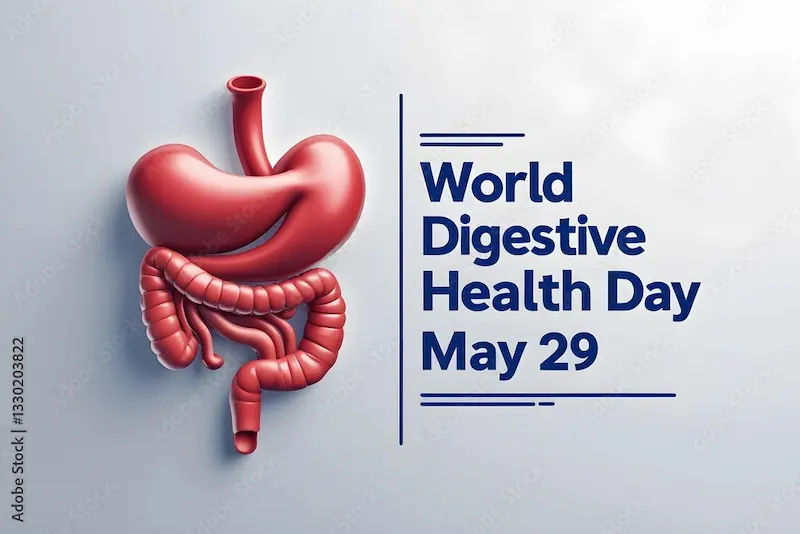Guide to Digestive Disorders Caused By Acute Pancreatitis
Acute pancreatitis can lead to long-term digestive issues like bloating, fatty stools (steatorrhea), and diabetes due to reduced enzyme production. Learn about Exocrine Pancreatic Insufficiency (EPI), required tests (faecal elastase, HbA1c), and treatment with Pancreatic Enzyme Replacement Therapy (PERT).

Written by Dr. Rohinipriyanka Pondugula
Reviewed by Dr. Shaik Abdul Kalam MD (Physician)
Last updated on 27th Oct, 2025

Introduction
Acute pancreatitis is a sudden inflammation of the pancreas—the small but powerful gland that helps you digest food and control blood sugar. Even after the “acute” phase settles, many people are surprised to experience lingering digestive disorders: bloating, greasy stools, weight loss, vitamin deficiencies, or new problems with blood sugar. This guide explains why digestive issues are common after an acute episode and what you can do about them.
We’ll walk through how acute inflammation can disrupt enzyme production and bile flow, leading to malabsorption and exocrine pancreatic insufficiency (EPI). You’ll learn the short- and long-term digestive complications to watch for, the tests that identify them (from faecal elastase to vitamin levels and HbA1c), and practical treatments—like pancreatic enzyme replacement therapy (PERT), smart meal planning, and targeted supplements. We’ll also cover prevention strategies to lower your risk of another attack and how to know when it’s time to speak with a doctor. If symptoms persist beyond two weeks, consult a doctor online with Apollo24|7 for further evaluation. For labs such as HbA1c or
vitamin D, Apollo 24|7 offers convenient home collection.
Whether you’re recovering from gallstones or alcohol-related acute pancreatitis, this step-by-step guide will help you protect your digestive health.
Consult a Top Gastroenterologist for Personalised Advice
What Is Acute Pancreatitis and How Does It Affect Digestion
Acute pancreatitis can temporarily or permanently impair the pancreas's ability to produce necessary digestive enzymes.
A quick tour of your pancreas and its digestive role
The pancreas sits behind your stomach and has two jobs. First, it makes digestive enzymes—lipase, amylase, and
proteases—that break down fats, carbohydrates, and proteins so you can absorb nutrients. Second, it makes hormones
like insulin and glucagon to regulate blood sugar.
Acute vs. chronic pancreatitis in plain language
Acute pancreatitis happens suddenly, often due to gallstones or heavy alcohol use, but also from high triglycerides,
certain medications, infections, or anatomic issues. Most cases resolve within days to weeks. Chronic pancreatitis, by
contrast, is persistent inflammation and scarring that often follows years of injury. Here’s the twist: even one severe
acute episode can temporarily or persistently impair digestion, leading to digestive disorders like malabsorption
Why “acute” inflammation can have lasting digestive effects
When the pancreas is inflamed, digestive enzymes may activate too early, injuring tissue and blocking ducts. This can
reduce enzyme output, disrupt bile flow, and inflame the small intestine. The result can be short-term feeding difficulties
and, in some cases, longer-term problems such as exocrine pancreatic insufficiency (EPI), steatorrhea (fatty stools), and even new-onset diabetes after pancreatitis. Research suggests EPI can occur in a substantial portion of patients after
acute pancreatitis, especially if the episode was severe or necrotising. Early recognition and treatment can restore
comfort and nutrition.
Why Acute Pancreatitis Causes Digestive Disorders
Damage to enzyme-producing cells and obstruction of ducts are the main drivers of post-pancreatitis digestive issues.
Inflammation, enzyme activation, and tissue injury
In acute pancreatitis, digestive enzymes can activate inside the pancreas instead of the intestine, triggering self-injury.
Swelling, fluid collections, and necrosis (dead tissue) can follow. The 2012 Revised Atlanta Classification categorises
severity and local complications—pseudocysts and walled-off necrosis—that may compress or obstruct nearby
structures. Damage to the acinar cells (the enzyme factories) can reduce enzyme output, setting the stage for EPI and
malabsorption.
Duct blockage, bile flow, and downstream malabsorption
Gallstone pancreatitis can block the common bile duct, leading to reduced bile in the intestine. Without adequate bile
and lipase, fat digestion suffers, causing steatorrhea, bloating, and deficiencies in fat-soluble vitamins (A, D, E, K).
Inflammation can also disrupt the gut barrier and motility, explaining early satiety and nausea. These changes help
explain why “digestive disorders” are a common legacy of an acute episode.
When acute pancreatitis transitions to longer-term problems
Even after symptoms settle, some people have persisting low enzyme output or damaged ducts that don’t drain well.
Meta-analyses show that EPI is common during hospitalisation and improves over time, but a notable minority have
persistent EPI months later. Similarly, glucose metabolism can be impaired after acute pancreatitis; some patients
develop “type 3c” diabetes (pancreatogenic diabetes), with risk higher after severe or necrotising attacks. Recognising
these patterns early allows targeted treatment, from PERT to glucose monitoring and nutrition support.
Short-Term Digestive Problems During and After an Acute Flare
Nausea and intolerance to food are common immediately after an episode, but early feeding is crucial for gut recovery.
Nausea, vomiting, ileus, and temporary intolerance to food
In the first days, inflammation can slow the gut (ileus), causing nausea, vomiting, distension, and pain. Historically,
patients were kept “NPO” (nothing by mouth), but modern guidelines favour early oral or enteral feeding as soon as it’s
tolerated because it helps maintain the gut barrier and reduces infections and complications. Clear liquids may progress
to a soft, lower-fat diet over 24–48 hours as nausea settles. For severe cases, feeding through a small tube into the
stomach or jejunum is preferred over IV nutrition.
Early feeding: why it helps the gut heal
Multiple studies and guidelines support early enteral nutrition in acute pancreatitis, which lowers the risk of infected
necrosis and mortality compared with parenteral (IV) nutrition. This approach reduces bacterial translocation and
supports the microbiome. Prophylactic antibiotics are not recommended unless infection is suspected or proven.
Probiotics are not routinely advised in severe or necrotising pancreatitis due to potential harm in some trials; discuss
with your clinician before using them.
Case snapshot: recovering from gallstone pancreatitis
Riya, 38, had gallstone-related acute pancreatitis. She tolerated oral feeding on day 2 and was discharged on day 4. A
week later, she noticed pale, oily stools and cramping. Her clinician checked a faecal elastase test and found borderline pancreatic enzyme output; a two-month course of pancreatic enzyme replacement therapy (PERT), a moderate-fat, high-protein diet, and vitamin D assessment resolved her symptoms. She underwent gallbladder removal the next month to prevent recurrence, consistent with guideline recommendations for gallstone pancreatitis.
If you’re struggling to restart eating or still have worsening symptoms after discharge, consult a doctor online with Apollo24|7. Rapid guidance can prevent setbacks.
Long-Term Digestive Disorders After Acute Pancreatitis
Exocrine Pancreatic Insufficiency (EPI) and new-onset diabetes are the primary lasting concerns for digestive health.
Exocrine pancreatic insufficiency (EPI) and steatorrhea
EPI means your pancreas isn’t making or delivering enough enzymes to digest food, especially fat. Symptoms include
bulky, oily stools that float or are difficult to flush, urgency, bloating, excess gas, weight loss, and fatigue. Meta-
analyses indicate that while many patients have EPI during the acute hospitalisation, around a quarter may have
persistent EPI months later; the risk is higher after necrotising pancreatitis or multiple attacks. Faecal elastase is a simple stool test to screen for EPI, and PERT often brings rapid symptom relief.
Post-pancreatitis diabetes (type 3c diabetes)
After acute pancreatitis, some develop impaired glucose tolerance or diabetes due to loss of insulin-producing cells and
changes in hormones that regulate blood sugar. A large systematic review found a significantly increased risk of new-onset diabetes after an acute episode, especially severe ones. Monitoring fasting glucose and HbA1c for at least a year is prudent. Management may include metformin or insulin, tailored to nutritional status and enzyme replacement. Because malabsorption can cause unpredictable calorie intake, coordinated care between gastroenterology and diabetes teams is helpful.
Nutrient deficiencies, weight loss, and bone health
Fat-soluble vitamin deficiencies (A, D, E, K) can follow malabsorption; vitamin D deficiency is common, contributing
to bone loss. Protein-calorie malnutrition can also occur. Dietitians often suggest energy-dense, protein-rich meals, MCT oil in select cases, and targeted supplements. Periodic checks of vitamin D, INR (vitamin K status), and B12/folate may be considered. Apollo24|7 offers home collection for tests like vitamin D and HbA1c, which can simplify monitoring.
Pseudocysts and gastric outlet/biliary obstruction
Fluid collections (pseudocysts or walled-off necrosis) can compress the stomach or bile duct, causing early fullness,
vomiting, jaundice, or persistent pain. Many resolve spontaneously; others require endoscopic drainage if symptomatic. If you notice worsening vomiting, yellowing of the eyes, or dark urine, seek urgent care.
Tests, Diagnosis, and When to See a Doctor
Diagnosis relies on a combination of blood work, imaging, and stool tests, with specific tests targeting EPI and diabetes.
Blood tests, imaging, and stool tests (faecal elastase)
Work-up depends on symptoms:
- Blood: pancreatic enzymes (amylase/lipase in the acute phase), liver tests (bile duct obstruction), triglycerides, glucose,
HbA1c, nutritional markers (albumin, prealbumin), and vitamin D. - Stool: faecal elastase-1 to screen for EPI; low values suggest poor enzyme output. Rarely, a 72-hour faecal fat collection
confirms malabsorption. - Imaging: ultrasound for gallstones; CT or MRI/MRCP for complications (pseudocysts, necrosis, ductal issues).
- Endoscopy: ERCP if persistent bile duct stone or cholangitis is suspected; endoscopic ultrasound (EUS) for fine-detail imaging.
Identifying EPI vs. other causes of digestive symptoms
Bloating and diarrhoea have multiple causes lactose intolerance, coeliac disease, irritable bowel syndrome, small
intestinal bacterial overgrowth (SIBO), or bile acid diarrhoea. Clues to EPI include oily stools, weight loss, and vitamin deficiencies. Your clinician may tailor tests to rule out other conditions if faecal elastase is borderline.
When to seek urgent care vs. routine follow-up
- Urgent: severe or increasing abdominal pain, persistent vomiting, fever, jaundice, black stools, or signs of dehydration.
- Soon: ongoing greasy stools, unexplained weight loss, or symptoms that don’t improve with initial treatment.
- Routine: nutrition follow-up at 4–12 weeks, and metabolic check (glucose/HbA1c) at 3–6 months and 12 months after
acute pancreatitis.
Red flags that should not wait
- Yellowing of skin/eyes, dark urine (possible bile duct blockage)
- High fever and worsening pain (possible infection)
- Inability to keep down liquids (risk of dehydration)
If your condition does not improve after trying these methods, book a physical visit to a doctor with Apollo 24|7. For
follow-up labs such as HbA1c or vitamin D, Apollo 24|7 offers convenient home collection.
Treatment, Recovery, and Everyday Self-Care
Treatment for post-pancreatitis disorders revolves around enzyme replacement, nutritional support, and preventing
future attacks.
Nutrition strategy: from the hospital to home
- Early oral or tube feeding during hospitalisation improves outcomes.
- At home, small, frequent meals can be easier to digest. A moderate-fat diet usually works well alongside PERT if EPI is
present; extremely low-fat diets are not necessary and may worsen nutrition. - Protein at each meal supports healing. Add complex carbs, fruits, and vegetables as tolerated.
- Hydration matters; aim for regular fluid intake, especially if stools are loose.
- Alcohol abstinence and smoking cessation are vital; both increase recurrence risk and slow healing.
Getting PERT right: dosing, timing, and troubleshooting
Pancreatic enzyme replacement therapy (PERT) replaces missing enzymes so you can digest food. General principles
(your clinician will individualise):
- Start with 25,000–40,000 units of lipase with meals and 10,000–25,000 with snacks; adjust to stool form, weight
stabilisation, and symptom relief. - Take enzymes with the first bite; for long meals, split the dose (half at the start, half mid-meal).
- If symptoms persist, first double the dose or add a proton pump inhibitor (to protect enzymes from stomach acid) before concluding PERT isn’t working.
- Practical tip: match the dose to fat content; higher-fat meals often need higher doses.
- Monitor for fat-soluble vitamin deficiencies and supplement as needed.
Managing glucose and preventing diabetes complications
Check fasting glucose and consider HbA1c at baseline, 3–6 months, and 12 months. If post-pancreatitis diabetes
develops, care may include diet therapy, metformin, or insulin. Because malabsorption changes calorie delivery, glucose
can fluctuate; pairing PERT with balanced meals stabilises readings. A registered dietitian can help time carbohydrates
and enzymes. Apollo24|7 can arrange home HbA1c testing to simplify monitoring.
Preventing recurrences: gallstones, alcohol, and smoking
- Gallstone pancreatitis: cholecystectomy is recommended—often during the index admission for mild cases—to reduce
recurrence - Alcohol-related pancreatitis: complete abstinence halves recurrence risk; seek support programmes if needed.
- High triglycerides: manage with diet, omega-3s, and medications as advised.
- Medication review: Some drugs rarely trigger pancreatitis; your clinician may adjust regimens.
Supplements that may be considered with your clinician
- Vitamin D, calcium, and fat-soluble vitamins if deficiencies are documented.
- Medium-chain triglyceride (MCT) oil can be a bridge in refractory fat malabsorption, used with guidance.
- Routine probiotics are not recommended after severe acute pancreatitis; discuss risks and benefits first.
Conclusion
An acute attack of pancreatitis may pass in days, but its digestive consequences can linger. Inflammation and duct disruption may reduce enzyme delivery and bile flow, causing malabsorption, steatorrhea, and nutrient deficits. Some people also develop post-pancreatitis diabetes as the pancreas’s hormone-producing cells are affected. The good news is that most digestive disorders after acute pancreatitis can be identified early and treated effectively.
Start with a structured plan: resume eating promptly as tolerated, watch for oily stools or weight loss, and discuss faecal elastase testing if symptoms suggest EPI. If EPI is present, pancreatic enzyme replacement therapy plus a protein-rich, moderate-fat diet often restores comfort and weight. Check glucose and HbA1c at intervals to catch diabetes early, and correct vitamin deficiencies—especially vitamin D—to protect bones and energy levels. For gallstone pancreatitis, timely gallbladder removal reduces recurrence risk.
Your recovery is a team effort. Gastroenterologists, dietitians, and if needed, diabetes specialists can tailor therapy to your symptoms and lifestyle. If your condition isn’t improving or you’re unsure about the next step, consult a doctor online with Apollo24|7. For labs such as HbA1c or vitamin D, Apollo24|7 offers convenient home collection. With the right monitoring and tools, you can move beyond the acute episode and safeguard your long-term digestive health.
Consult a Top Gastroenterologist for Personalised Advice
Consult a Top Gastroenterologist for Personalised Advice

Dr. Chethan T L
General Physician/ Internal Medicine Specialist
5 Years • MBBS, MD, DNB (General Medicine)
Bengaluru
Apollo Medical Center, Marathahalli, Bengaluru

Dr. Nikhil Patil
Gastroenterology/gi Medicine Specialist
10 Years • MBBS
Bengaluru
Apollo Medical Center, Marathahalli, Bengaluru

Dr. Jatin Yegurla
Gastroenterology/gi Medicine Specialist
11 Years • MD (PGI), DM (AIIMS Delhi), FAGIE (AIIMS Delhi), ESEGH (UK), Gold Medalist
Hyderabad
Apollo Hospitals Jubilee Hills, Hyderabad
(650+ Patients)

Dr. Amit Pandita
Gastroenterology/gi Medicine Specialist
10 Years • MBBS. MD (INTERNAL MEDICINE) DrNB (GASTROENTEROLOGY AND HEPATOLOGY)
Delhi
Apollo Hospitals Indraprastha, Delhi

Dr Piyush Vishwakarma
Gastroenterology/gi Medicine Specialist
11 Years • MBBS, MD, DrNB,
Delhi
Apollo Hospitals Indraprastha, Delhi
Consult a Top Gastroenterologist for Personalised Advice

Dr. Chethan T L
General Physician/ Internal Medicine Specialist
5 Years • MBBS, MD, DNB (General Medicine)
Bengaluru
Apollo Medical Center, Marathahalli, Bengaluru

Dr. Nikhil Patil
Gastroenterology/gi Medicine Specialist
10 Years • MBBS
Bengaluru
Apollo Medical Center, Marathahalli, Bengaluru

Dr. Jatin Yegurla
Gastroenterology/gi Medicine Specialist
11 Years • MD (PGI), DM (AIIMS Delhi), FAGIE (AIIMS Delhi), ESEGH (UK), Gold Medalist
Hyderabad
Apollo Hospitals Jubilee Hills, Hyderabad
(650+ Patients)

Dr. Amit Pandita
Gastroenterology/gi Medicine Specialist
10 Years • MBBS. MD (INTERNAL MEDICINE) DrNB (GASTROENTEROLOGY AND HEPATOLOGY)
Delhi
Apollo Hospitals Indraprastha, Delhi

Dr Piyush Vishwakarma
Gastroenterology/gi Medicine Specialist
11 Years • MBBS, MD, DrNB,
Delhi
Apollo Hospitals Indraprastha, Delhi
More articles from Acute Pancreatitis
Frequently Asked Questions
1) How do I know if I have exocrine pancreatic insufficiency after acute pancreatitis?
Look for steatorrhea (oily, difficult-to-flush stools), bloating, and weight loss. Ask your clinician about a faecal elastase test. If EPI is confirmed, pancreatic enzyme replacement therapy dosing can relieve symptoms quickly.
2) Do I need a low-fat diet during recovery?
Very low-fat diets are usually unnecessary. A balanced, moderate-fat diet paired with the right PERT dose is more effective for pancreatitis malabsorption symptoms. A dietitian can personalise your plan.
3) What’s the risk of diabetes after acute pancreatitis?
There’s a higher risk of post-pancreatitis diabetes (type 3c diabetes), especially after severe attacks. Monitoring fasting glucose and HbA1c at 3–6 and 12 months is recommended. Apollo24|7 offers home HbA1c collection.
4) When should gallbladder surgery happen after gallstone pancreatitis?
For mild cases, guidelines often recommend cholecystectomy during the same admission or shortly after to reduce recurrence. Discuss timing with your surgeon.
5) Are probiotics helpful after severe acute pancreatitis?
Routine probiotics are not recommended in severe or necrotising pancreatitis and may be harmful in some settings. Talk to your clinician before using them.

